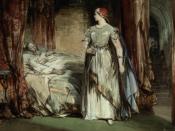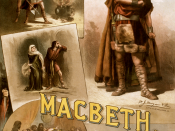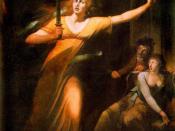Shakespeare uses many types of imagery in his famous tragedy, Macbeth. One well known example is his use of blood. It emerges throughout the play in various scenes, representing many characteristics. The appearance of the blood is widely known to represent death and violence. In addition, the blood represents not only denial and guilt, but also courage. Throughout the play, the blood imagery could fall under either category of the brave warrior or the vicious foe.
Bravery is a quality easily identified by Shakespeare's imagery. In Act I, scene 2, Macbeth shows great bravery by defeating the Thane of Cawdor. His courageous aid in the battle, the bloody sergeant, hails the "brave Macbeth - well he deserves that name -," (I, 2, 16). Not only does Macbeth deserve recognition for noble heroism in the presence of blood, but so does Fleance in Act III, Scene 3. The murders attack Banquo and his son Fleance under Macbeth's orders, attempting to kill them both.
In the midst of the struggle, Fleance escapes. The brave escape of Fleance during the bloody battle definitely upsets Macbeth because Fleance represents the powerful future that Macbeth cannot have.
Contrasting from courage, the image of blood also represents denial. During Act II, Scene 1, the imagined bloody dagger rises before Macbeth which he perceives as a omen showing him the answer to the puzzling question of what to do with Duncan. Macbeth uses his vision to help him decide to murder the faithful king, thus placing the fault of the murder not completely on himself, but on the vision as well. Continuing with the theme of denial, in Act IV Scene 1, Macbeth visits the witches again to try and straighten out his future. The witches show him an apparition of a bloody baby. The baby...


